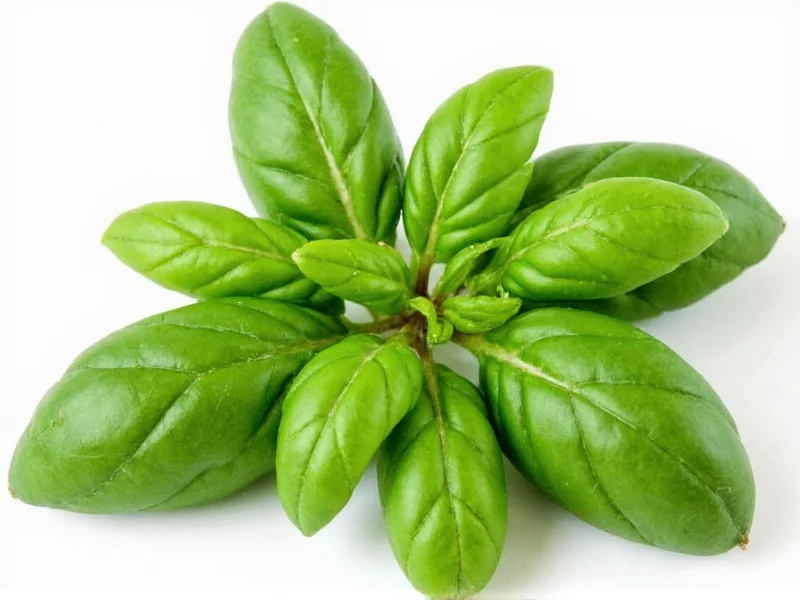Understanding herb conversions is essential for consistent cooking results. When substituting dried basil for fresh in your recipes, this fundamental ratio ensures your dishes maintain proper flavor balance without becoming overpowering or bland.
Why the 3:1 Conversion Ratio Makes Sense
When basil undergoes the drying process, it loses approximately 90% of its water content. This dehydration concentrates the essential oils and flavor compounds, resulting in dried basil being three times more potent than fresh. The evaporation of moisture leaves behind a more intense herbal profile that requires careful measurement when substituting.
Consider the cellular structure of fresh basil leaves—they're mostly water with flavor compounds dispersed throughout. As the water evaporates during drying, those flavor compounds become densely packed in the remaining plant material. This scientific principle applies to most herbs, though the exact concentration factor varies slightly between different varieties.
Precise Basil Conversion Measurements
While the 3:1 ratio serves as a reliable starting point, having specific measurements for various cooking scenarios proves invaluable. Refer to this comprehensive conversion guide when adapting recipes:
| Fresh Basil | Dried Basil Equivalent | Best For |
|---|---|---|
| 1 cup chopped | ⅓ cup | Large batch sauces, pesto base |
| ½ cup | 3 tablespoons | Medium sauces, soups |
| ¼ cup | 1½ tablespoons | Small sauces, dressings |
| 2 tablespoons | 2 teaspoons | Marinades, rubs |
| 1 tablespoon | 1 teaspoon | Finishing touches, delicate dishes |
| 1 teaspoon | ¼ teaspoon | Subtle flavor enhancement |
When to Adjust the Standard Ratio
Several factors might require tweaking the standard conversion ratio for optimal results:
- Herb age and quality - Older dried basil loses potency over time. If your dried basil is more than a year old, you might need to increase the amount slightly
- Cooking method - For dishes with long simmering times, reduce dried basil by 25% since flavors intensify during prolonged cooking
- Recipe acidity - In highly acidic dishes like tomato sauces, dried herbs maintain potency better, so stick strictly to the 3:1 ratio
- Personal preference - Some palates detect subtle flavor differences between fresh and dried, requiring minor adjustments
Flavor Profile Differences Between Fresh and Dried Basil
Understanding the distinct flavor characteristics helps determine when each form shines:
Fresh basil offers bright, sweet notes with hints of anise and pepper. Its delicate flavor works best in dishes where the herb remains raw or receives minimal cooking—think caprese salads, fresh pesto, or as a garnish for finished dishes.
Dried basil develops earthier, more concentrated flavors with subtle woody undertones. The drying process alters some volatile compounds, creating a different but equally valuable flavor profile that excels in cooked dishes like tomato sauces, soups, stews, and meat rubs where extended cooking time allows the flavors to fully integrate.
Storage Tips for Maximum Flavor Preservation
Proper storage significantly impacts the potency and shelf life of both basil forms:
Fresh basil: Treat like cut flowers—trim stems and place in a glass with water, covering loosely with a plastic bag. Store at room temperature away from direct sunlight. For longer storage, freeze whole leaves in olive oil using ice cube trays.
Dried basil: Keep in an airtight container away from heat, light, and moisture. The ideal storage temperature is below 60°F (15°C). Properly stored dried basil maintains peak flavor for 6-12 months. Test potency by rubbing a small amount between your fingers—if the aroma is weak, it's time to replace.
Common Substitution Mistakes to Avoid
Even experienced cooks sometimes make these basil substitution errors:
- Adding dried basil too late - Unlike fresh basil, dried needs time to rehydrate and release flavors. Add at least 15-20 minutes before dish completion
- Not adjusting salt levels - Stronger herb flavors can make dishes taste saltier. Reduce salt by 10-15% when using dried herbs
- Using dried basil in raw applications - Dried basil won't properly rehydrate in cold dishes, resulting in unpleasant texture and uneven flavor
- Ignoring visual presentation - Dried basil turns dark when cooked, affecting dish appearance. Consider adding fresh basil at the end for color contrast
Special Considerations for Different Cuisines
Culinary traditions often have specific preferences for fresh versus dried basil:
Italian cooking typically favors fresh basil for signature dishes like pesto and caprese, while dried works well in slow-simmered tomato sauces. Thai cuisine almost exclusively uses holy basil or Thai basil fresh, as drying alters the distinctive anise-like notes crucial to authentic flavor. Mediterranean dishes often blend both forms—dried in spice blends like herbes de Provence, fresh as finishing garnish.
When adapting international recipes, research traditional preparation methods. Some cuisines developed techniques specifically around available herb forms, and substitutions might alter the dish's fundamental character.











 浙公网安备
33010002000092号
浙公网安备
33010002000092号 浙B2-20120091-4
浙B2-20120091-4